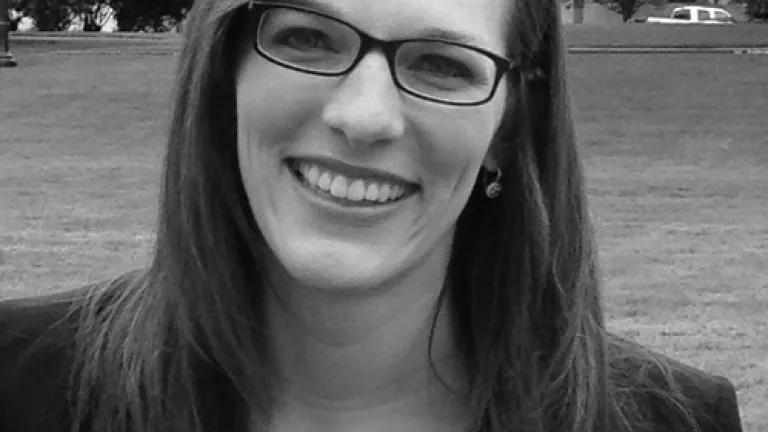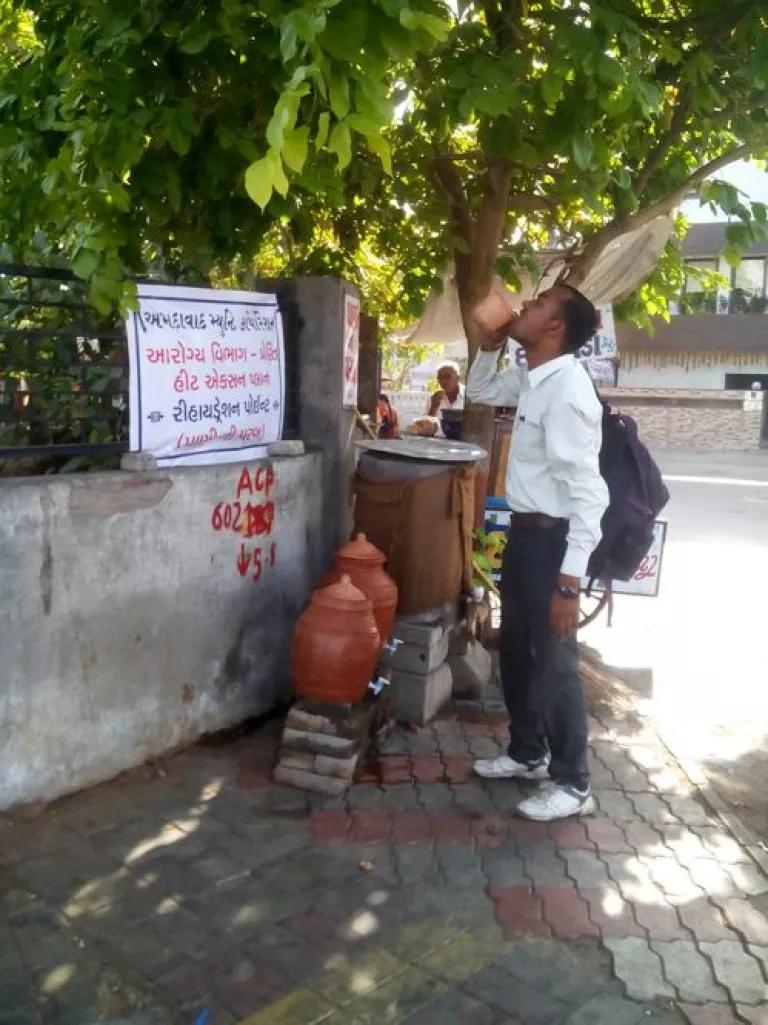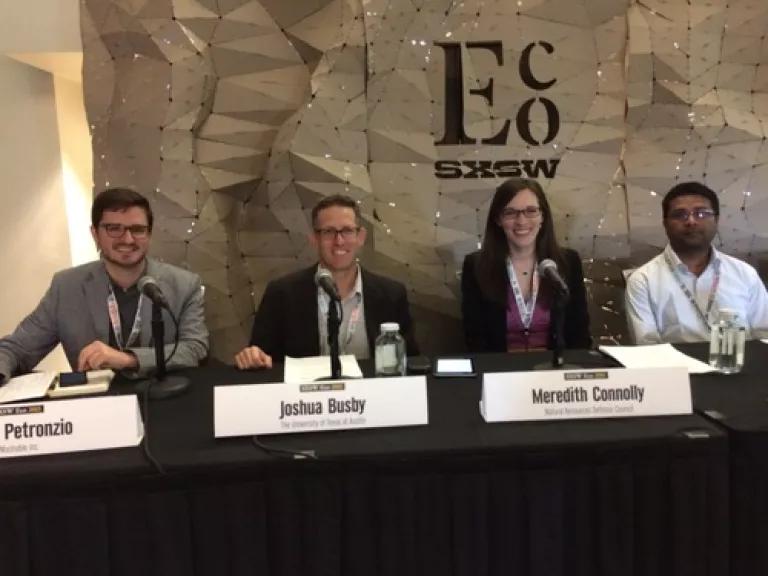From Austin to Ahmedabad: Building Heat-Resilient Cities on the Frontlines of Climate Change

If temperatures are so hot that they are melting asphalt in Delhi, how can the human body cope with rising temperatures?
How can we build heat-resilient cities to better protect people from worsening heat waves?
What can someone sitting in the U.S. do about climate impacts in vulnerable developing countries?
These are some of the questions posed by the participants at the SXSW Eco conference last week during our panel on Climate and Heat Adaptation in the Developing World. Leaders and experts from tech start-ups and businesses to non-profits and academic groups presented their insights and innovative solutions to many of the world's environmental ills, with clean energy, climate change and urban resiliency at the forefront of many panelists' discussions. I had the opportunity to present on NRDC's work addressing the health threats posed by increasing heat waves in India. Because this conference was attended by engaged, tech-savvy folks, the tweets circulated by the audience during our panel offer a nice guide to the conversation that unfolded.

City resident getting a drink at a water station in Ahmedabad, India, during the heat wave in May 2015. (c) Ahmedabad Municipal Corporation.
"Heat is not recognized as a natural disaster in India, because its always been hot" but we are approaching unseen temperatures @gulrezdoc
-- Josh Mogerman (@JoshatNRDC) October 7, 2015
"While it has always been hot, the temperatures we are seeing in India are beyond what the human body can adapt to." @ConnollyMer #SXSWEco
-- Andrew Kornblatt (@akornblatt) October 7, 2015
Dr. Josh Busby of University of Texas, Austin laid the context for what climate vulnerability looks like in Asia by using data and analytics to create vulnerability maps. Dr. Gulrez Azhar described why India is particularly vulnerable to climate change impacts, including devastating events like the May 2015 heat wave that claimed over 2,300 lives. Some startling statistics he laid out:
- India has always been hot, but the temperatures experienced now are record-setting and deadly - and projected to get even worse due to climate change. During the devastating May 2015 heat wave - ranked the 5th deadliest heat wave in world history - cities like Khamman and Allahabad suffered temperatures spiking as high as 118°F (48°C).
- Only 3% of urban households in India currently have air conditioning - and even many hospitals don't have A/C - making extreme temperatures a major health threat.
- India houses 1/5th of the world's population, yet the country has only has 4% of global freshwater resources.
- Exacerbating this, the projected migration of 250 million people from India's rural areas to urban centers between 2008 and 2030 and resulting urbanization is straining cities' limited resources and infrastructure. That's the equivalent of the population of Indonesia moving to Indian cities over the course of 2 decades.
Heat and climate change resiliency issues are global problems that require local solutions in local communities. #SXSWEco
-- Kimiko Martinez (@kimikokopuffs) October 7, 2015
Although those realities paint a daunting picture, there are opportunities to better prepare local communities on the frontlines of climate change to build resilience to rising temperatures. I had the opportunity to talk about one of these tangible climate solutions during our panel: the Ahmedabad Heat Action Plan, which was the first early warning system and preparedness plan for extreme heat in South Asia.

Our SXSW Eco 2015 panel (from left): moderator Matt Petronzio of Mashable; Dr. Josh Busby of University of Texas, Austin; Meredith Connolly of NRDC; Dr. Gulrez Shah Azhar of Public Health Foundation of India
The Ahmedabad Municipal Corporation (AMC) partnered with a coalition of local and international scientists and policy experts to develop the Heat Action Plan. The coalition of partners included the Indian Institute of Public Health, Gandhinagar, Public Health Foundation of India (PHFI), NRDC, Icahn School of Medicine at Mount Sinai, and Rollins School of Public Health at Emory University. Georgia Institute of Technology's CFAN group provided a pioneering daily 7-day forecast to the AMC to help them determine when to declare a heat alert.
@nrdc is helping to build climate-resilience for communities on the front lines of dealing with climate change right now. #SXSWEco
-- Kimiko Martinez (@kimikokopuffs) October 7, 2015
In 2013 @ConnollyMer @NRDC_India helped Ahmedabad set up the first heat action plan in all of South Asia. #SXSWEco
-- Josh Mogerman (@JoshatNRDC) October 7, 2015
Heat action plan intervention: early warning system. A "heat alert" triggered response throughout city, agencies, hospitals, etc. #SXSWEco
-- Kimiko Martinez (@kimikokopuffs) October 7, 2015
The Ahmedabad Municipal Corporation (AMC) launched the Heat Action Plan in 2013. A severe heat wave that hit in 2010 caused 1,300 deaths in this urbanizing city of 7 million people. The Heat Action Plan is tailored to protect and reach the city's most vulnerable populations: elderly, young children, slum communities and outdoor workers.
Ahmedabad's Heat Action Plan has a four-pronged approach to reduce heat-related health impacts and mortality:
- Building public awareness and community outreach to communicate the risks of heat waves and implement practices to prevent heat-related deaths and illnesses. This includes disseminating public messages on how to protect people against extreme heat through inter-personal contact, traditional media outlets and modern mediums such as WhatsApp, and informational materials such as pamphlets and advertisements on heat stress prevention.
- Initiating an early warning system and inter-agency coordination to alert residents of predicted high and extreme temperatures. The AMC has created formal communication channels to alert governmental agencies, the meteorological department, health officials and hospitals, emergency responders, local community groups, and media outlets of forecasted extreme temperatures.
- Capacity building among health care professionals to recognize and respond to heat-related illnesses, particularly during extreme heat events. These strategies are paired with straight-forward measures like stocking emergency rooms and ambulances with ice packs.
- Reducing heat exposure and promoting adaptive measures by launching new efforts including mapping of high-risk areas of the city, increasing outreach and communication on prevention methods, access to increased potable drinking water stations and cooling spaces during extreme heat days.
After three years in action, the Plan is having an impact by saving lives and protecting residents of Ahmedabad from dangerously high temperatures. Other cities and states across the country are now using Ahmedabad's Heat Action Plan as a model for shaping heat preparedness plans and early warning systems for their own citizens, a much needed priority after this summer's historic heat wave. The cities of Nagpur, Bhubaneswar and Surat are actively working towards adopting heat action plans of their own, with Odisha and Gujarat states also exploring regional plans. Government officials and public health experts from these cities and states, as well as national level officials, came to New York City last month to exchange best practices on climate and heat adaptation with local experts. NRDC and IIPH are also working with the government to integrate heat into the disaster management framework at the national level.
What can we do? - Figure out what your local city is doing to prepare for #climatechange impacts, get plans going - @ConnollyMer #SXSWEco
-- Josh Mogerman (@JoshatNRDC) October 7, 2015
"#Climatechange is a health issue and it is happening here too...important to remember it is a human issue" @ConnollyMer #SXSWEco
-- Andrew Kornblatt (@akornblatt) October 7, 2015
Awareness is still low about climate change impacts that are happening now, both here and among vulnerable communities around the world. Talking about these climate disasters like the unprecedented heat waves in India and droughts across the Western U.S. is a critical first step that can lead to greater awareness and action.
It's also important to remember that heat waves are not just threatening lives and livelihoods in developing countries. Even here in the U.S., climate change impacts, including extreme heat, threatens health and takes lives. Only one-third of U.S. states have any kind of climate-health preparedness planning and even fewer states and cities have heat-health early warning systems. Making sure all local government leaders are planning and supporting climate health preparedness efforts is crucial to increasing resilience in the face of rising temperatures and a changing climate.
"Adaptation and mitigation are two sides of the same coin" when it comes to #climatechange @ConnollyMer #SXSWEco
-- Andrew Kornblatt (@akornblatt) October 7, 2015
350 million people in #India still don't have electricity. Solar and wind becoming priorities; 5th most wind energy in the world. #SXSWEco
-- Kimiko Martinez (@kimikokopuffs) October 7, 2015
A discussion on the real need for greater climate adaptation efforts is incomplete without also focusing on how to mitigate global warming, thereby reducing future impacts on vulnerable populations. Already one of the top 5 countries for wind installation worldwide, India is becoming a clean energy leader - with targets of achieving 100 gigawatts of solar and 60 GW of wind energy by 2022. India's newly released climate commitments (called Intended Nationally Determined Contributions or "INDCs") looks to achieve 40% of electricity from non-fossil fuel sources by 2030. Focusing on reaching the over 300 million people without electricity primarily in rural areas through off-grid clean energy solutions is another priority.
All of these efforts can help bend the trajectory of global temperature rise and provide a safer, healthier future for everyone. I hope the momentum at SXSW Eco can carry forward and generate more innovative solutions to the climate crisis bearing down on us all, from Austin to Ahmedabad.
